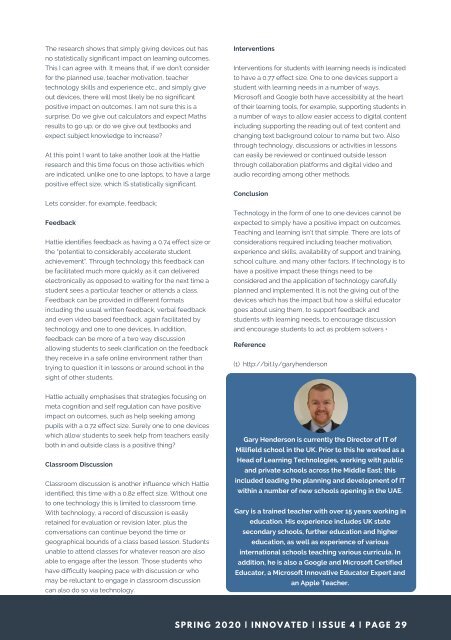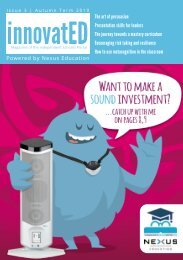innovatED Magazine - Issue 4 - Spring 2020
A mixture of news, opinion, research, ideas, great practice and regulatory updates. innovatED takes a global perspective and brings the latest educational developments from across the world onto your laptop, smartphone - and with the printed edition - into your staff room.
A mixture of news, opinion, research, ideas, great practice and regulatory updates. innovatED takes a global perspective and brings the latest educational developments from across the world onto your laptop, smartphone - and with the printed edition - into your staff room.
You also want an ePaper? Increase the reach of your titles
YUMPU automatically turns print PDFs into web optimized ePapers that Google loves.
The research shows that simply giving devices out has<br />
no statistically significant impact on learning outcomes.<br />
This I can agree with. It means that, if we don’t consider<br />
for the planned use, teacher motivation, teacher<br />
technology skills and experience etc., and simply give<br />
out devices, there will most likely be no significant<br />
positive impact on outcomes. I am not sure this is a<br />
surprise. Do we give out calculators and expect Maths<br />
results to go up, or do we give out textbooks and<br />
expect subject knowledge to increase?<br />
At this point I want to take another look at the Hattie<br />
research and this time focus on those activities which<br />
are indicated, unlike one to one laptops, to have a large<br />
positive effect size, which IS statistically significant.<br />
Lets consider, for example, feedback;<br />
Feedback<br />
Hattie identifies feedback as having a 0.74 effect size or<br />
the “potential to considerably accelerate student<br />
achievement”. Through technology this feedback can<br />
be facilitated much more quickly as it can delivered<br />
electronically as opposed to waiting for the next time a<br />
student sees a particular teacher or attends a class.<br />
Feedback can be provided in different formats<br />
including the usual written feedback, verbal feedback<br />
and even video based feedback, again facilitated by<br />
technology and one to one devices. In addition,<br />
feedback can be more of a two way discussion<br />
allowing students to seek clarification on the feedback<br />
they receive in a safe online environment rather than<br />
trying to question it in lessons or around school in the<br />
sight of other students.<br />
Interventions<br />
Interventions for students with learning needs is indicated<br />
to have a 0.77 effect size. One to one devices support a<br />
student with learning needs in a number of ways.<br />
Microsoft and Google both have accessibility at the heart<br />
of their learning tools, for example, supporting students in<br />
a number of ways to allow easier access to digital content<br />
including supporting the reading out of text content and<br />
changing text background colour to name but two. Also<br />
through technology, discussions or activities in lessons<br />
can easily be reviewed or continued outside lesson<br />
through collaboration platforms and digital video and<br />
audio recording among other methods.<br />
Conclusion<br />
Technology in the form of one to one devices cannot be<br />
expected to simply have a positive impact on outcomes.<br />
Teaching and learning isn’t that simple. There are lots of<br />
considerations required including teacher motivation,<br />
experience and skills, availability of support and training,<br />
school culture, and many other factors. If technology is to<br />
have a positive impact these things need to be<br />
considered and the application of technology carefully<br />
planned and implemented. It is not the giving out of the<br />
devices which has the impact but how a skilful educator<br />
goes about using them, to support feedback and<br />
students with learning needs, to encourage discussion<br />
and encourage students to act as problem solvers •<br />
Reference<br />
(1) http://bit.ly/garyhenderson<br />
Hattie actually emphasises that strategies focusing on<br />
meta cognition and self regulation can have positive<br />
impact on outcomes, such as help seeking among<br />
pupils with a 0.72 effect size. Surely one to one devices<br />
which allow students to seek help from teachers easily<br />
both in and outside class is a positive thing?<br />
Classroom Discussion<br />
Classroom discussion is another influence which Hattie<br />
identified, this time with a 0.82 effect size. Without one<br />
to one technology this is limited to classroom time.<br />
With technology, a record of discussion is easily<br />
retained for evaluation or revision later, plus the<br />
conversations can continue beyond the time or<br />
geographical bounds of a class based lesson. Students<br />
unable to attend classes for whatever reason are also<br />
able to engage after the lesson. Those students who<br />
have difficulty keeping pace with discussion or who<br />
may be reluctant to engage in classroom discussion<br />
can also do so via technology.<br />
Gary Henderson is currently the Director of IT of<br />
Millfield school in the UK. Prior to this he worked as a<br />
Head of Learning Technologies, working with public<br />
and private schools across the Middle East; this<br />
included leading the planning and development of IT<br />
within a number of new schools opening in the UAE.<br />
Gary is a trained teacher with over 15 years working in<br />
education. His experience includes UK state<br />
secondary schools, further education and higher<br />
education, as well as experience of various<br />
international schools teaching various curricula. In<br />
addition, he is also a Google and Microsoft Certified<br />
Educator, a Microsoft Innovative Educator Expert and<br />
an Apple Teacher.<br />
S P R I N G 2 0 2 0 | I N N O V A T E D | I S S U E 4 | P A G E 2 9






